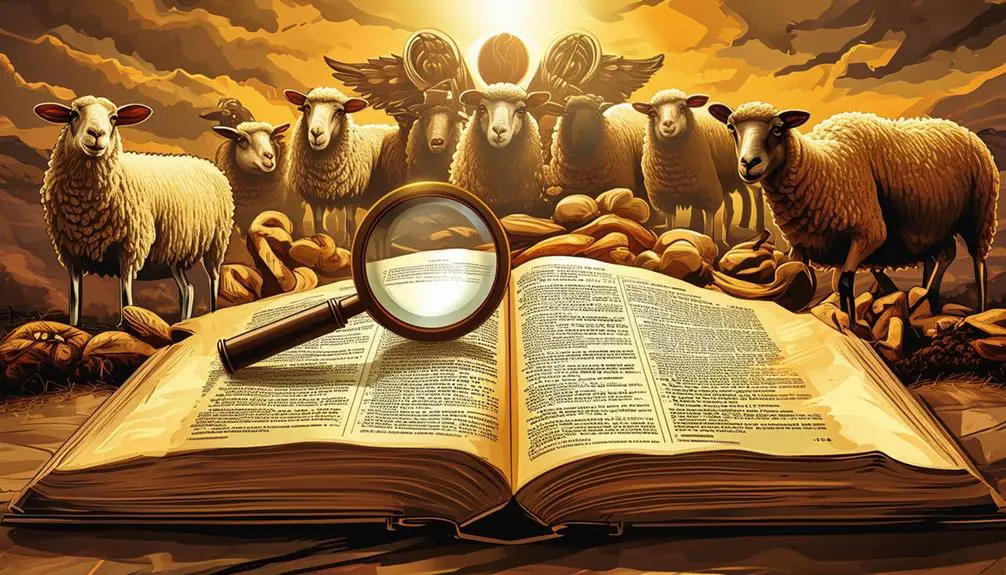Brace yourself for an enlightening journey through Genesis 31, a chapter filled with divine intervention, deceit, and transformation.

Bible Study – The Book of Genesis – Chapter 31 – Summary and Analysis
In Genesis 31, you're invited into Jacob's intricate ordeal under Laban's deception. Throughout this chapter, you'll dissect their intense dispute and ultimate covenant, with divine intervention being a constant. Jacob's trials, contrasted with Laban's trickery, serve as a proof to faith, resilience, and personal transformation. You'll examine motifs like dream interpretation, idolatry, and the societal norms of their patriarchal culture. A thorough exploration into this chapter is certain to provide rich insight, and further investigation will enhance your understanding of intricate biblical themes. Onward, for enlightening discoveries await you.
Key Takeaways
- Genesis 31 details Jacob's transformation and spiritual growth, highlighting his struggle against Laban's deception.
- Key themes include personal introspection, spiritual development, human relationships, faith, and God's sovereignty.
- The chapter illustrates the interplay of divine intervention and deception, with God guiding and protecting Jacob.
- Laban's self-interest and manipulation are contrasted with Jacob's ethical conduct, symbolizing the struggle between good and evil.
- Studying Genesis 31 offers deeper understanding of faith and relationships, while providing lessons on contemporary morality and conflict resolution.
Genesis 31: Brief Overview

Diving right into Genesis Chapter 31, you'll find a multifaceted narrative that unfolds a critical juncture in the lives of the patriarch Jacob and his family. 'Jacob's Transformation' is a central theme, marked by his growth from a self-serving trickster into a responsible family man and servant of God.
Jacob's transformation isn't just a personal journey. It's a mirror to 'Laban's Deception', a contrasting element that amplifies Jacob's moral evolution. Laban's deceptive tactics, once a tool used by Jacob himself, now become the force propelling Jacob's character development.
Yet, Jacob's transformation isn't immediate. It's a tangled process of realization, regret, and redemption, interspersed with moments of doubt and fear. It's a dynamic, powerful journey that charts the course of Jacob's spiritual growth.
Laban's deception, on the other hand, serves as a stark reminder of Jacob's past. Laban's manipulative ways reveal a striking resemblance to Jacob's former self, driving home the point of Jacob's evolution. In Laban's unchanging ways, we see the reflection of Jacob's past, a vivid contrast to his present state of growth and transformation.
Thus, Genesis 31 is a riveting narrative of transformation, deception, and spiritual growth, offering profound insights into human nature and divine intervention.
Historical Context of Chapter 31
To fully grasp the depth of Genesis 31, it's important to understand the historical context in which it was written. This chapter takes place in an era where the culture was mainly patriarchal and nomadic. The cultural context is key to understanding the actions and decisions of the characters within the text.
The patriarchal society meant that men held the primary power, including control over property and women. This is reflected in Laban's control over his daughters and in the struggle between Jacob and Laban. The nomadic lifestyle also played a significant role, as it often led to conflicts over resources, such as water and grazing lands for livestock.
Social implications of this time also influenced the narrative. For instance, societal norms dictated that Laban, as the girls' father, had the power to determine their marital arrangements. Moreover, the concept of divine intervention was prevalent, as ancient societies often attributed unexplainable events to the work of gods. This is evident in Laban's dream, where God intervenes to protect Jacob.
Detailed Verse-by-Verse Summary

As we proceed to explore Genesis Chapter 31, you'll encounter a thorough, verse-by-verse analysis. This investigation will illuminate the intricate details, themes, and implications within each verse. Your understanding of this pivotal chapter will deepen through this scholarly examination, empowering you to appreciate the profound wisdom within the ancient text.
Genesis 31: Detailed Analysis
Often, you'll find that Genesis 31 is a chapter filled with intrigue and revelations, when examined verse-by-verse. Here, we explore two main themes: 'Laban's Deception' and 'Rachel's Idolatry'.
- 'Laban's Deception': You observe Laban's deceptive practices affecting Jacob's livelihood, manipulating him with changing wages and breeding conditions.
- 'Rachel's Idolatry': Rachel's theft of her father's household gods reveals a deep-seated idolatry, contradicting the monotheistic faith of her husband Jacob.
- Interpersonal Conflict: The strained relationship between Laban and Jacob escalates, resulting in a covenant of non-aggression.
- Divine Intervention: God's active involvement in Jacob's life is evident, protecting him from Laban's wrath and guiding his decisions.
This analysis helps you appreciate the rich tapestry of Genesis 31, steeped in deception, faith, conflict, and divine intervention.
Interpreting Key Verses
Having explored the broader themes of Genesis 31, let's now turn our focus to a more detailed examination of key verses, allowing you a closer look at the intricate narrative. In verse 7, Jacob mentions Laban's deception, highlighting deceit as a recurring theme. This is echoed in verse 12, where divine intervention comes into play. Here, God reveals Laban's deceit through a dream, illustrating the intersection of human misconduct and divine justice. In verse 24, we see another instance of divine intervention, where God warns Laban against harming Jacob. This verse emphasizes the protective role of the divine in the face of human deception. Through a closer analysis, the subtle interplay of divine intervention and deception themes in Genesis 31 becomes more evident.
Deep Analysis of Jacob's Actions
Let's turn our attention to the detailed analysis of Jacob's actions in Genesis Chapter 31. You'll examine Jacob's decision to flee, explicate the meaning of dream symbols, and assess the consequences of his actions. In doing so, we'll gain a scholarly understanding of Jacob's complex character and his pivotal role in this biblical narrative.
Jacob's Decision to Flee
In a profound turn of events, you'll find that Jacob's decision to flee is not just a hasty escape, but a calculated move underscored by deep-seated fears, strategic planning, and a divine intervention. This decision was shaped by:
- Jacob's Motivation: His deep desire for freedom and autonomy.
- Family Dynamics: The tension and hostility within his family.
- Divine intervention: God's instruction to return to his homeland.
- Strategic planning: His secret departure while Laban was away.
Jacob's actions reflect a man who's not only driven by fear but also by the desire to establish his own identity independent of his father-in-law. His decision to flee is a manifestation of his resilience and determination to change his circumstances.
Interpretation of Dream Symbols
To fully understand Jacob's actions, you'll need to explore the symbolism found in his dreams, a key element that shaped his decision-making process. Dream symbolism and Biblical metaphors are pivotal to grasp Jacob's mindset in Genesis 31. In his dream, Jacob saw speckled and spotted animals mating, symbolizing his future prosperity despite Laban's deception. Stripes, spots, and speckles in Biblical metaphors often represent variety, diversity, and potential. This dream was a divine indication, guiding his actions to eventually leave Laban's household. Hence, his dream wasn't mere subconscious rumination, but a divine revelation. Interpreting these dream symbols is essential to understand Jacob's character and his faith-driven actions. It's a reflection of his unwavering belief in divine providence.
Consequences of Jacob's Actions
Exploring the ramifications of Jacob's actions, you'll discover an array of outcomes that greatly altered his life's trajectory. When analyzing Jacob's Deception, it's essential to acknowledge that:
- Jacob's duplicity led to conflict with Laban, his father-in-law.
- His actions caused a rift within his family, leading to mistrust and upheaval.
- His deceit, although initially profitable, later caused significant hardship.
- Divine Intervention played a pivotal role in protecting Jacob from the consequences of his actions, even though he was far from perfect.
These points highlight that Jacob's actions, though driven by ambition and survival, carried significant consequences. Nonetheless, Divine Intervention demonstrated God's grace, safeguarding Jacob, and ensuring the fulfillment of His divine plan despite human failings.
Interpretations of Laban's Behavior
Analyzing Laban's actions throughout Genesis Chapter 31, you'll encounter varying interpretations that shed light on his complex character. A significant aspect to examine is Laban's motivations. His behavior is primarily driven by self-interest and material gain. The wealth and prosperity Jacob brought to his household were likely the main catalysts for Laban's actions.
Further scrutiny into Laban's deception reveals a man skilled in manipulation. He repeatedly deceives Jacob about his wages, changing them ten times, and even attempts to take advantage of God's blessing on Jacob to enrich himself. His actions reflect a cunning character, willing to exploit relationships for personal gain.
However, there's an alternate interpretation that portrays Laban as a protective family patriarch. His pursuit of Jacob can be seen as a quest to safeguard his daughters and his grandchildren, rather than a mere chase for wealth. In this light, his actions may be justified as a desperate attempt to preserve familial ties.
The Covenant Between Jacob and Laban

Reflect on Jacob's dream interpretation and its profound effects on his decision to form a covenant with Laban. You'll find the agreement between Jacob and Laban to be layered with complexities, each rooted deeply in the socio-religious context of the time. The careful examination of these points will reveal nuances that enhance our understanding of this pivotal biblical event.
Jacobs Dream Interpretation
In a profound revelation, Jacob's dream interpretation reveals a pivotal covenant between him and Laban, a narrative that's packed with symbolic significance. The dream revelation is a clear case of Divine intervention, aimed at resolving Jacob's predicament.
Consider these points:
- The spotted and speckled sheep represent Jacob's wages, which Laban had been unjustly withholding.
- The dream signifies God's justice, asserting Jacob's rightful claim.
- The dream served as a Divine intervention, a means to communicate God's will and purpose.
- The dream also foreshadows Jacob's future prosperity, in spite of Laban's trickery.
In essence, Jacob's dream interpretation not only underscores his spiritual insight but also reinforces his trust in Divine justice and provision. It's a tale of divine intervention that shapes destiny.
Laban and Jacobs Agreement
Despite Laban's continual deceit, you'll find that the covenant between Jacob and Laban showcases the intricacies of their relationship, marked by manipulation yet bound by mutual agreement. This covenant, constructed amidst Laban's deception, is a testament to Jacob's shrewd negotiation skills. It serves as a turning point in their relationship, setting boundaries and mitigating further exploitation. Notably, even in the face of deception, Jacob's prosperity steadily increases. This prosperity could be seen as a divine reward for his perseverance and integrity. Additionally, the covenant signifies an essential shift in power dynamics. Jacob's prosperity, juxtaposed with Laban's deception, highlights the biblical principle that God's favor rests upon the righteous, regardless of the surrounding deceit and manipulation. This agreement profoundly influences their future interactions.
Symbolism in Genesis 31
Diving into the rich tapestry of Genesis 31, you'll find it's brimming with potent symbolism that deepens your understanding of the narrative. Two pivotal events, Laban's deception and Rachel's theft, serve as catalysts for this symbolism.
Laban's deception signifies the exploitation of power and authority. This act symbolizes a broader theme of corruption and the misuse of power prevalent in society. In contrast, Rachel's theft of her father's household idols symbolizes rebellion against patriarchal authority and the struggle for autonomy.
Genesis 31 also uses symbolism to explore themes of:
- Conflict and resolution
- Deception and its consequences
- Transformation and growth
- The divine role in human affairs
The conflict between Jacob and Laban symbolizes the larger struggle between good and evil. Laban's deception and the consequences that follow symbolize the universal principle of karma. Jacob's transformation from a timid man into a strong leader symbolizes personal growth and development. Finally, the divine intervention in Jacob's dream embodies the omnipresent role of God in human affairs.
In understanding these symbolisms, you'll appreciate the depth of Genesis 31, enhancing your Bible study experience. Remember, these symbols aren't just elements of a story. They're tools to convey profound truths and lessons.
Modern Applications of Genesis 31
Having explored the symbolic richness of Genesis 31, let's now consider how its themes and lessons can be applied in today's context.
Genesis 31 offers a rich tapestry of stories, providing lessons on contemporary morality and showcasing examples of divine intervention. Jacob's honest labor despite Laban's deception, for instance, can be viewed as a model for ethical conduct in our dealings, emphasizing the importance of integrity even in adverse circumstances.
Meanwhile, the divine intervention that guided Jacob in his time of distress can be seen as a reminder of the providence that guides our lives, particularly when we face challenges or difficult decisions.
The table below provides a concise summary of these modern applications:
Genesis 31 Themes |
Modern Applications |
|---|---|
Jacob's Integrity |
Model for Contemporary Morality |
Divine Guidance |
Reminder of Divine Intervention |
Family Relationships |
Basis for Interpersonal Interactions |
Conflict Resolution |
Framework for Addressing Disputes |
Controversies and Debates
In exploring Genesis 31, you'll inevitably encounter a number of controversies and debates that stimulate scholarly discourse and offer profound insights into the interpretation of this biblical chapter. Of particular note is the Divine Intervention Controversy and the Biblical Inconsistencies Debate.
The Divine Intervention Controversy focuses on the question of how to interpret God's intervention in Jacob's life. Some argue that this is a literal divine intervention, whereas others consider it to be a metaphorical representation of Jacob's internal transformation.
The Biblical Inconsistencies Debate revolves around the inconsistencies in the narrative of Genesis 31. Scholars grapple with questions such as why Laban pursued Jacob, and why Rachel stole her father's idols.
To explore further, consider these key points:
- The interpretation of divine intervention is subjective, based on one's theological perspective.
- Genesis 31 contains narrative inconsistencies that require critical analysis.
- The reasons behind Rachel's theft of the idols remain unclear.
- Laban's pursuit of Jacob raises questions about his motivations.
Through these discussions, you'll find a richer understanding of Genesis 31, challenging preconceptions and deepening your biblical knowledge. As you engage with these controversies, remember to maintain an open mind and a critical perspective.
Personal Reflections and Insights
As you reflect on these debates and controversies, you'll likely gain personal insights that may reshape your understanding of Genesis 31. A thorough exploration into this chapter using a structured reflection methodology can lead to a more profound interpretation. The dynamic interactions between Jacob, Laban, and their respective families offer invaluable lessons about personal integrity, trust, and the importance of covenant relationships.
A careful analysis of these narratives can contribute to your spiritual growth. You'll start to appreciate how the characters' actions and decisions, guided by their faith and fear of God, mirror our own struggles and triumphs in life. The events in Genesis 31 aren't just historical accounts; they're timeless lessons of trust, betrayal, and reconciliation.
In essence, your understanding of Genesis 31 isn't just about knowing the events that transpired. It's about personal introspection and spiritual development. It's about recognizing the complexities of human relationships, the essence of faith, and the overarching sovereignty of God. As you continue to explore further, you'll find more layers of wisdom and insight, ultimately enriching your spiritual journey.
Frequently Asked Questions
What Is the Significance of Genesis 31 in the Overall Narrative of the Bible?
In Genesis 31, you'll see two significant events: Jacob's departure and Laban's pursuit. These highlight the theme of God's providence. Jacob's escape signifies his liberation from Laban's exploitation, while Laban's pursuit and subsequent peace treaty demonstrate God's protection over Jacob. It's a turning point for Jacob, showing his growth and reliance on God. This chapter is pivotal in understanding God's guidance in the lives of His chosen people.
How Does Genesis 31 Relate to Other Religious Texts?
In your study of Genesis 31, you'll notice similarities with other religious texts, creating a bridge for interfaith interpretations. Just like a seed sprouting roots, Genesis 31's narrative of conflicts, deceptions and divine intervention spreads across religious literature. This comparative study reveals common themes of faith, obedience, and divine providence, connecting the Biblical story with other religious narratives. Your understanding of Genesis 31 is enriched by this broader, interfaith perspective.
What Are Some Artistic or Cultural Representations of the Events in Genesis 31?
You'll find various depiction variations in art and culture representing Genesis 31's events. From Renaissance paintings to modern interpretations, artists often explore symbolism within this chapter's narrative. Jacob's dream, Laban's pursuit, and the covenant feast are popular scenes creatively expressed. These portrayals not only reflect the artist's interpretation but also indicate societal perceptions and religious beliefs of different periods. It's fascinating to see the variety of artistic responses to this biblical episode.
How Has Genesis 31 Influenced Various Theological Perspectives?
Genesis 31's influence on theological shifts can't be understated. You'd see how it's shaped different doctrines, particularly around covenant relationships and divine providence. It's given theologians a rich narrative to explore themes of trust, obedience, and divine intervention. You'd notice its impact on interpretations of God's sovereignty and faithfulness. So, it's not just a historical account, but a theological cornerstone, influencing many perspectives on the divine-human relationship.
What Are Some Scholarly Criticisms or Alternate Readings of Genesis 31?
You'll find that Genesis 31 interpretations vary. Some scholars critique the chapter's historical accuracy, suggesting it reflects cultural context more than factual events. Others offer alternate readings, interpreting the text metaphorically or symbolically rather than literally. It's essential to take into account these viewpoints when studying any biblical text, as they can broaden your understanding and spark meaningful discussion.



Sign up